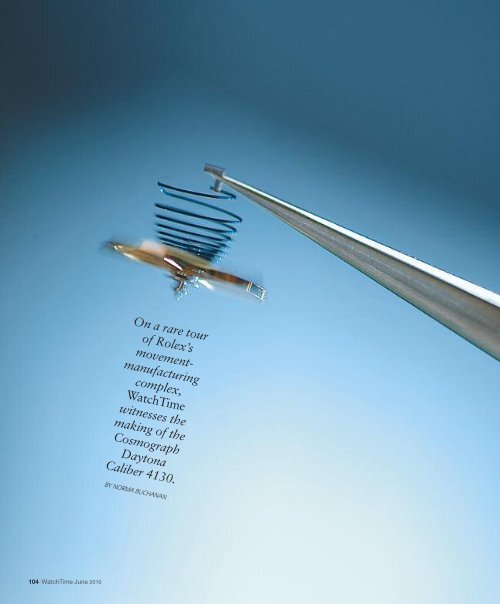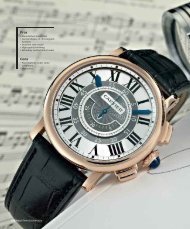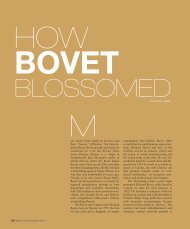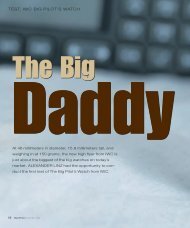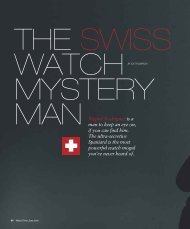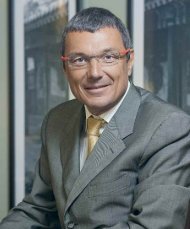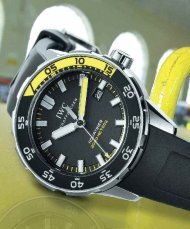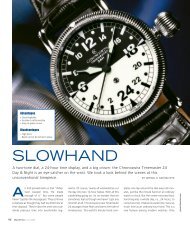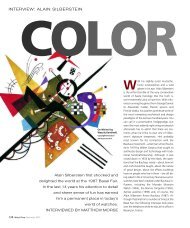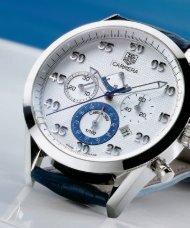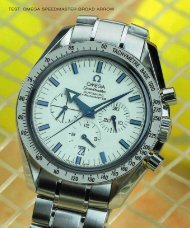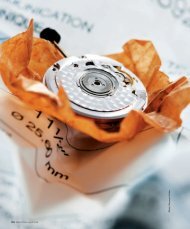WT_2010_03: PROFILE: ROLEX BIENNE
WT_2010_03: PROFILE: ROLEX BIENNE
WT_2010_03: PROFILE: ROLEX BIENNE
- No tags were found...
Create successful ePaper yourself
Turn your PDF publications into a flip-book with our unique Google optimized e-Paper software.
InsideRolexBienne
Components aremade by machine andassembled by hand.June <strong>2010</strong> WatchTime 107
<strong>PROFILE</strong>Rolex Bienneploying 150 people, where some movementassembly takes place.Until 2004, Rolex Bienne and RolexGeneva had different owners. The formerbelonged to the descendants of Jean Aegler,whose Aegler SA factory in Bienneprovided movements to Rolex founderHans Wilsdorf starting in 1905. (Formore on the history of Rolex Bienne, see“The Bienne Connection” sidebar).Rolex Geneva was, and still is, owned bythe Hans Wilsdorf Foundation, whichWilsdorf established in 1945.Six years ago, Rolex Geneva boughtthe Bienne facility and the two weremerged. That move, along with Rolex’slong-term project of acquiring many ofits suppliers of components and equipment,has transformed the company intoa vertically integrated manufacture.CLASS OVER, we set out on the tour. Itwill have a theme, says FrançoisPaschoud, one of the facility’s technicaldirectors: We will be following the manufacturingsteps of Rolex’s famous Caliber4130, the chronograph movement thatRolex launched in 2000 to replace theZenith El Primero caliber it had been usingin its Cosmograph Daytona models.That introduction was a major event forRolex; it meant that from that point on allmovements used in the Rolex brand weremade in-house (watches in Rolex’s sisterbrand, Tudor, have ETA movements).Besides Paschoud, our guides on thetour are the facility’s top manager, RaymondKerrison, and Jacques Baur, headof research at Rolex.We start in Rolex V, in the departmentwhere the movement’s plates and bridgesare made. There, in a huge room filledwith the roar of toiling machines, we seesomething — or rather some things —we’ve never seen before. They look likegiant, round, glass pods, or maybe spaceships,nearly as high as the ceiling and 12feet or so in diameter. The Rolex officialscall them “modules.” There are a dozenof them, some connected at the top to anadjacent module by metal rails, which,we soon learn, are a kind of monorailtransit system for carrying componentsfrom one module to the next. Four of themodules are dedicated to the 4130. InsidePlates and bridges aremanufactured by CNCmachines inside huge,pod-like modules.108 WatchTime June <strong>2010</strong>
<strong>PROFILE</strong>Rolex Bienneeach one, a cluster of CNC machines arestamping, drilling, milling, turning andpolishing the plates, the rough forms ofwhich were produced, by the stampingprocess, in another department. We cansee almost none of the actual work fromoutside the modules; the machines havetheir backs turned to us, as it were, andare facing inside. What we do see is oil,gallons and gallons of it, which is squirtedon the plates and bridges to lubricatethem during manufacturing and to rinseoff metal shavings.To see the actual processes, such asmilling and stamping holes in the plates,we watch a movie on a video monitor.There are more than 50 tools working simultaneouslyin the four modules. Humansare far scarcer in this room: just oneor two are needed to keep the noisy machineshumming.The modules are made exclusively forRolex by a Rolex-owned company. Theyserve several purposes. Most obviously,they contain the oil that would otherwisebe knee-deep on the factory floor. Theyalso protect the components and machineryfrom dust. Thirdly, they keep thecomponents at the same precise temperaturethroughout the manufacturingprocess so they will neither shrink nor expand.Any such change, however small,would have disastrous consequences giventhe tolerances involved: two microns,IN 2004, <strong>ROLEX</strong><strong>BIENNE</strong> MERGEDWITH <strong>ROLEX</strong>GENEVA TO FORMA VERTICALLYINTEGRATEDMANUFACTURE.that is, two thousandths of a millimeter,or, as Paschoud says, a few hundredths ofthe diameter of a human hair.When one module completes its work,the plate or bridge moves to the next moduleby means of the monorail. Each componentis mounted on its own small pallet.Human hands never touch the componentduring this phase of production. Theentire process consists of about 100 differentsteps. (Some are performed nextdoor, in Rolex III.) There are some 350points of measurement for each plate.Leaving the department, we pass thequality control section where, helped byprecision measuring equipment and magnifyinglenses, employees in two separatedepartments check the plates and bridgesto be sure they have exactly the rightmeasurements and are free of any surfaceflaws. They work behind a glass partitionin a controlled environment. That,Paschoud tells us, is because a temperaturechange of as little as 1 degree can affecta component’s measurements.If the plates and bridges pass muster,they are sent to another department forrhodium galvanic coating and decoration:circular graining, for instance.WE THEN WALK through an undergroundpassageway connecting Rolex Vto Rolex IV, where small componentssuch as staffs, wheels (including balanceRolex V is one of the four big buildingsin the Bienne complex.
<strong>PROFILE</strong>Rolex BienneRolex balances have goldMicrostella screws andParachrom hairsprings.<strong>ROLEX</strong> INTRO-DUCED THEPARACHROMHAIRSPRINGWHEN ITLAUNCHEDTHE 4130MOVEMENT ADECADE AGO.wheels), and Microstella screws, whichare used to adjust the balance, are made.On the way, we pass a man riding a bicycle(another watch-factory first forus). There are more bikes, special Rolexbikes, with light-colored tires, parked atthe elevator in Rolex IV. Employees usethem to move quickly between thebuildings.This department’s job is to turn barsand tubes of metal, some two meterslong, into pieces as small as one millimeteracross. Tolerances here are as tiny astwo microns. The parts are made byturning, cutting, stamping and spark erosionperformed by CNC machines. As inthe plates-and-bridges department, muchof the work is hidden within the machines.The metal, an alloy of steel, aluminumor copper, goes in one end and,seemingly by magic, comes out the otherin the form of infinitesimally smallscrews (the Microstella screws are madeof gold) or tiny wheels. Decoration alsotakes place here: wheels, for instance, receivea sunray finish.Our guides show us one machine thatis making a pivot for a winding rotor, acomponent that is still in the testing stageand is hence being produced in a small series.Paschoud pulls out a mechanicaldrawing of the pivot, which is just 2.5 mmlong and 2.2 mm wide, with a diameter of0.3 mm at its end. It’s a simple thing, butthe drawing is so complicated, and dottedwith so many measurements, you’d thinkit depicted a nuclear submarine.ALL THESE COMPONENTS come togetherin Rolex VI, our next stop, whichwe reach through another undergroundpassageway. Before we go in, we don disposablewhite lab coats and blue plasticshoe coverings so we won’t track dirt inside.The latter are dispensed by a machine(by now we expect no less): we stickour feet, one at a time, smartly into themachine and the booties’ elastic-bandtops snap shut around our ankles.But before we get to the movementassemblydepartment, we’re in for a treat,a glimpse at something even inveteratewatch-factory tourists seldom see. We’regoing to watch hairsprings being made.And not just any hairsprings, but blue112 WatchTime June <strong>2010</strong>
The Parachrom is made in agiant furnace (above, left) with aporthole (left) for viewing thealloying process (above).Parachrom ones, which are unique toRolex.The company introduced Parachromhairsprings in the 4130 when the movementwas first launched a decade ago.Since then, they have worked their wayinto all Rolex-brand men’s watches (thewomen’s models, along with the company’sCellini collection, have hairspringsmade of an alloy identical to that used byNivarox). The advantages of Parachrom,says Jacques Baur, is that it has superiorshock-resistance and anti-magnetism.There are two models of Parachrom hairsprings.One is made for the 4130 and4160 (a relative of the 4130 used in theYacht-Master II). The other is for the3100-series non-chronograph men’swatchcalibers, used in the GMT-MasterII, Submariner, Deepsea, Day-Date, Datejust,Explorer, and Milgauss.Parachrom is an alloy of 85 percentniobium and 15 percent zirconium.Rolex makes it itself, by taking 30-centimeterrods of each element, two of niobiumand one of zirconium, clumpingthem together and melting them so thatthey become a homogenous alloy.The melting takes place inside an electron-beamvacuum furnace, a tall, shinybehemoth that reaches up through the ceilingand looks kind of like a rocketship, albeita rather chubby one. Like the modulesin Building V, it’s a Rolex exclusive. And,like them, it makes us gape because it’s sobig and odd-looking. We’re invited to peekinto the furnace. The Rolex executiveswarn us that the light inside it can damageour eyes if they’re unprotected, and handus dark goggles. We climb up on a viewingplatform, put on the goggles, and peer intothe furnace through a porthole. Therewe see the soon-to-be Parachrom rod beingheated by a burning stream of electronsto a temperature of 2,400 degreesCentigrade. The rod glows with fiery intensity.It is heated one section at a time:the rod will pass through the electron firethree times before the metal is completelyblended. The process is entirely automatic,but a technician observes it on a videomonitor to make sure nothing goes awry.Parachrom blended, it’s time to turn itinto hairsprings. That requires a marathonseries of stretching and flattening opera-
Workers assemblingmovements with the Juraforest in the backgroundtions, punctuated by occasional heat treatmentsto soften the metal so that it can beworked. When they’re over, the original30-centimeter-long rod, which is one centimeterin diameter, will be three kilometerslong and about 0.1 millimeter thick(the exact thickness will vary according tothe type of hairspring being made). A singlerod yields 10,000 hairsprings.The first stretching process is coldrolling. It’s performed by two men in labcoats who stand on either side of therolling machine, passing the ever-thinnerrod back and forth through ever-smallernotches in the machine. They seem like ananachronism in this world of advancedtechnology. The reason flesh-and-bloodworkers perform this task, Baur explains,is that the metal is quite brittle when it firstcomes out of the furnace and must be handledvery carefully until it develops someelasticity. When the men are finished, thebar is three meters long.Machines take over again for the nextprocess: wire drawing. We stop to watchone machine pulling the wire through foursuccessive dies as it becomes ever thinner.It will pass through about 50 dies in all.Then the wire, which is still round,like a pencil, is flattened by a techniquecalled high-precision cold rolling. It takesplace in its own, temperature-controlledroom. We can’t go inside, Baur tells us:the change in room temperature causedby our presence would ruin the wire. Thethickness tolerances the machines mustmeet are 0.1 microns. We peer throughthe glass at the machine and can barelysee the wire: at the end of the process, it is50 microns thick and 150 microns wide.Now the straight wire is turned intoa coiled spring, manually, through a delicateand painstaking process called, inFrench, estrapadage. A woman takesthree 20-centimeter segments of wireand, with a dexterity that amazes us,threads one end of each segmentthrough a thinner-than-a-hair notch inthe middle of a lifesaver-shaped mold,affixing the strands at the center so theywill stay in place. She then rotates themold, as if it were a potter’s wheel, causingthe three wires to wrap around thespindle within the mold. The reasonthree wires are coiled in one mold, Baurexplains, is to provide the correct spacingand hence the correct curvature foreach coil. The mold is heated so the wirewill retain its new shape. Then, using atweezers, the technician separates thethree springs, which are about 6 millimetersin diameter. Difficult as the coilingprocess is, Baur tells us, separatingthe springs is much harder: one tiny slipof the tweezers and the springs are rendereduseless.What about the springs’ blue color,we ask. They’re a nice shade of cobalt orCONTINUED ON PAGE 118
<strong>PROFILE</strong>Rolex BienneThe Bienne ConnectionPerched on a slope overlooking Bienne’sOld Town is a building with, at its top,big green letters spelling “Rolex,”flanked by two yellow crowns. The buildingis a Bienne landmark, an importantpart of the city’s history. But what happenedinside affected not just Biennebut the whole watch world.This was once the factory of the movementmaker Aegler SA. Aegler was foundedin 1878 by Jean and Anna Maria Aegler,just as Bienne was hitting its stride as amajor watchmaking center. The companyspecialized in small, precision watchmovements. After Jean Aegler died, in1891, his son Hermann took the businessover, continuing to make the same type ofmovements. (The building with the Rolexsign was built by Hermann Aegler in 1914;the original, smaller factory that JeanAegler built is right in front of it.)Small, high-precision movementswere just what Hans Wilsdorf, an ambitious,young German-born watch-industryentrepreneur, needed. As the 20thcentury dawned, Wilsdorf had becomeconvinced that, despite the nay saying ofnearly everyone in the watch business,the wristwatch would one day prevailover the pocketwatch.In 1905, Wilsdorf’s company, Wilsdorf& Davis, based in London, placed ahuge order with Aegler for movementsto use in wristwatches. Three years later,Wilsdorf gave a brand name to his line ofwristwatches: Rolex. It was destined tobecome the world’s biggest, most famous,luxury watch brand. (Wilsdorf &Davis changed its name to Rolex WatchCo. in 1915.)Through the decades that followed,Aegler’s firm in Bienne continued tomake movements for Wilsdorf’s company.It developed several important innovations,the most famous of which is theself-winding system, based on the 18thcenturynotion of a spinning rotor. Wilsdorfnamed this system the “Perpetual.”Its inventor was Aegler SA’s technical directorand chief, Emile Borer, whopatented the device in 1931. (Borermarried into the Aegler family.)In the meantime, Wilsdorf had, in1919, moved from London to Geneva,where his company made cases forAegler SA’s movements, assembled thewatches, and sold them all over theworld. In his memoirs, he explained that“we want to leave to our factory inBienne exclusively the production ofwatch movements, while we ourselvescreate in Geneva case models adapted tothe refined taste of the Genevans.”(Wilsdorf’s calling the Aegler factory“our factory” refers to the fact that, forpart of Rolex history, Rolex had partialownership of the Aegler factory.)The Rolex Geneva-Bienne division oflabor established more than a centuryago continues to this day. Bienne makesthe movements; Geneva makes justabout everything else, then assemblesthe watches and markets them.What has ended, though, is the twocompanies’ separate ownership. In2004, Rolex Geneva, now called RolexSA, acquired Rolex Bienne (Manufacturedes Montres Rolex SA), which had belongedto descendants of the Aegler-Borer family.Rolex founder Hans WilsdorfThe Aegler-Rolex factory in Bienne circa 1955116 WatchTime June <strong>2010</strong>
<strong>PROFILE</strong>Rolex BienneCONTINUED FROM PAGE 115royal blue, very close to the color of bluedsteel screws or watch hands.The color is produced by an oxidationprocess, we’re told. It not only spruces upthe springs’ appearance, it makes themmore stable — that is, better able to performconsistently over a long period oftime. We are not allowed to see the bluingoperation: it’s a Rolex secret.We do get a look at one of the lasthairspring-making steps: the bending ofthe outer end of the spring into aBreguet overcoil. It is done automaticallyby a machine, another Rolex exclusive,which is fitted with two flat hammersthat strike the spring at precisepoints to bend it at the correct angles.But because the Parachrom has tiny inconsistenciesfrom spring to spring, andthus responds slightly differently to thehammer strikes, an employee looksthrough a microscope to check the precisecurvature of each spring. If needed,she makes adjustments using the hammermachine.NOW IT’S TIME to see all the parts uniteto form Caliber 4130. We go to the movementassembly department. There, workersspecialize in specific assembly tasks.One person puts the gear train together.Another mounts the balance and, usingan electric screwdriver programmed toprovide just the right amount of torque,screws down the balance bridge. We seethe 4130 come to life: its blue hairspringstarts to expand and shrink as if it’sbreathing.To protect the movements from dustwhile they’re being assembled, they’replaced on a horizontal, rotating carrouselunderneath the watchmaker’s bench.Each movement — there are 10 on eachcarrousel — pops up through a hole inthe bench when its turn comes to beworked on. It then drops down again andthe next movement presents itself. Thetechnicians’ hands move as deftly as ifthey were those of robots performing microsurgery.Then a machine lubricates the movements.We watch a video screen as themachine places tiny droplets of oil oneach tooth of an escape wheel. All told,there are 200 different points in themovement that need lubrication. Thecompany uses five types of lubricant ineach caliber. There’s one lubricant for thewinding barrel, for instance, another forthe chronograph mechanism. Some of theA rendering of the as-yet-unbuilt Rolex VIIbuilding (in foreground), planned forcompletion in 2012118 WatchTime June <strong>2010</strong>
The final product:the CosmographDaytonaTHE LAST STEPWE SEE IS THEASSEMBLY OFCHRONOGRAPHCOMPONENTSON THE BASEMOVEMENT,MAKING THE4130 COMPLETE.oils are manufactured in-house; others byoutside suppliers using recipes exclusiveto Rolex. Important as lubricants are(Baur says the stress endured by somecomponents is equal, relative to size, tothe stress a train imposes on a traintrack), they’re applied in almost traceamounts. Each year, the company usesjust 10 liters of oil for all the movementsit makes and services.The next stop on the tour is the fineadjustment department. There, an employeecorrects the movement’s rate sothat it will meet COSC standards. Using atiny wrench, she turns the gold screws;Rolex has named them Microstellascrews because of their star-like shapes.There are four of them, in two sizes, allfour affixed to the inner edge of the balancewheel.When she finishes, the movement isrunning as precisely as anyone couldwant. But it’s missing something: it’s notyet a chronograph. That’s soon remedied:a watchmaker assembles the chronographcomponents onto the base movement.She uses a needle-thin applicator toplace lubricant in eight different places inthe chronograph mechanism. She screwsthe bridge into place. Then she checks herwork, starting and stopping the chronographto make sure the column wheel,clutch, hammers, cams and all else workcorrectly. Bingo.The movement will now be sent toCOSC, either to the agency’s Bienne officeor to its Geneva facility. In 2008,COSC certified 769,850 Rolex movements.(COSC data for 2009 will be releasedin August.)Just one stop remains. Standing inthe top-floor restaurant in Rolex VI, welook out through the picture window atan enormous construction project. That,we’re told, is Rolex VII. When it’s finished,in 2012, it will provide an additional230,000 cubic meters of space. Itwill house, among other things, a robotizedcomponents storage and deliverysystem that will transport parts to distantwork stations in a matter of minutes.The new extension will be connectedto Rolex IV and VI, creating onemega production unit.Soon giant Rolex will be bigger still.June <strong>2010</strong> WatchTime 119


